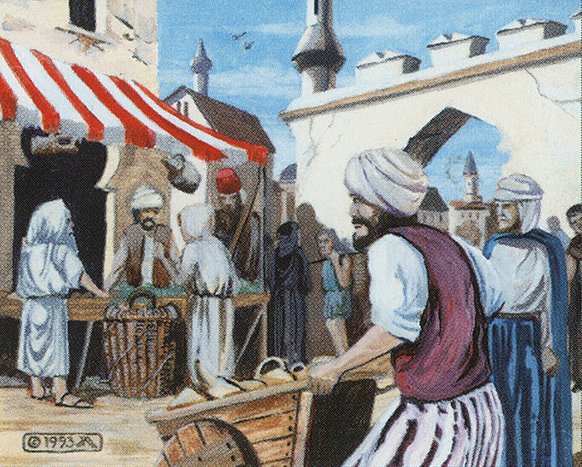 Art by Jeff A. Menges
Art by Jeff A. MengesCloned from Synergy Peasant Cube
SYNERGY PEASANT CUBE for 8-10 Players Setting:Cards that were printed at least once in either common or uncommon according to the Gatherer. This includes even the most powerful and expensive (un-)commons like Bazaar of Baghdad. The only exceptions are the Pain Lands, to provide untapped mana fixing.
Goals:Drafting one of the given synergistic archetypes or a combination of them. Most archetyped are based around one of the folllowing synergies: Overruns/Tokens, Sacrifice, ETB Triggers, Graveyard/Reanimate, Heroic/Pump.
Eventhough the decks are made of just commons and uncommons, they can be quite streamlined and some of them are able to win as early as turn 3-4.
In general, your decks will have 2 base colors and optionally splash one or more colors. The mana costs are very demanding so mana fixing is recommended for all decks (even 2-color decks).
Land cycles:10 Pain Lands Adarkar Wastes
10 Bounce Lands Selesnya Sanctuary
10 MH3 Landscapes Bountiful Landscape
5 Vivid Lands Vivid Marsh
5 Cycle Lands Forgotten Cave

 Selesnya Auras/Tokens
Selesnya Auras/Tokens

 Boros Heroic/Aggro-Tokens
Boros Heroic/Aggro-Tokens

 Gruul Berserk/Grave-Matters
Gruul Berserk/Grave-Matters

 Orzhov Sacrifice/Enchantment-Loop
Orzhov Sacrifice/Enchantment-Loop

 Izzet Prowess/Contol
Izzet Prowess/Contol

 Azorius Blink/Curiosity/Heroic
Azorius Blink/Curiosity/Heroic

 Rakdos Madness/Reanimator/Sacrifice
Rakdos Madness/Reanimator/Sacrifice

 Dimir Ninja/Reanimator
Dimir Ninja/Reanimator

 Golgari Dredge
Golgari Dredge

 Simic Land-Untap with Fatties/Storm/Blink-Combo
The Archetypes explained:
Simic Land-Untap with Fatties/Storm/Blink-Combo
The Archetypes explained:

 Selesnya Auras/Tokens
Selesnya Auras/Tokens
Auras tries to attach as many auras as possible (Rancor, Gryff's Boon) on creatures that are difficult to kill (Shanna, Sisay's Legacy, Adanto Vanguard). It uses spells like Alseid of Life's Bounty, Spirit Mantle or Apostle's Blessing for further protection. There are several different pay off cards for this theme like Gatherer of Graces, Ancestral Mask, Ethereal Armor.
Tips: There are a lot of tokens and ETB creatures that can block your creatures forever. Evasion in the form of flying and trample is key. Creature based removal (Shriekmaw) can both kill and block your creatures. Enchantments that give protection from colors/creatures (Holy Mantle, Benevolent Blessing) solve both of these problems.
Tokens uses green mana dorks Llanowar Elves to cast white token producers (Spectral Procession) as early as possible. A single green Overrun is usually enough to finish off the game in a single attack.
Tips: Tromp the Domains offers a second Overrun effect. Note that 3 basic land types are enough, you don't need to splash for more.
Example Decks: Tokens, Auras, Grave-Auras

 Boros Heroic/Aggro-Tokens
Boros Heroic/Aggro-Tokens
Heroic plays creatures with the ability Heroic (Hero of Iroas) and targets them with spells that protect them from removal (Apostle's Blessing, Hyena Umbra) and spells that make them unblockable (Gryff's Boon, Spirit Mantle, Invigorated Rampage).
Tips: There are a lot of tokens and ETB creatures that can block your creatures forever. Evasion in the form of flying and trample is key. Creature based removal (Shriekmaw) can both kill and block your creatures. Enchantments that give protection from colors/creatures (Holy Mantle, Benevolent Blessing) solve both of these problems.
Aggro-Tokens combines cheap token producers (Raise the Alarm) with small anthem effects (Goblin Bushwhacker).
Tips: Sacrifice outlets (Goblin Bombardment, Bogardan Dragonheart) offer another angle of attack when the anthem game plan is not enough.
Example Decks: Tokens, Heroic

 Gruul Berserk/Grave-Matters
Gruul Berserk/Grave-Matters
Berserk and other pump spells that give trample, double strike or double the power (Assault Strobe, Legion Leadership, Aloe Alchemist) are used to finish the game with a single attack of one gigantic creature.
Tips: Since there are many tokens and ETB creatures that can block, trample is essential for this combo to work. Initially you usually need a first pump spell (Collision // Colossus, Rancor) to grow your creatures and give trample before doubling and double striking can be effective. Instant speed removal is a problem. The way to beat it is having an aggro plan that forces the opponent to spend removal/tap out. Once they do, you kill them.
Graveyard-Matters uses cards with Threshold (Grizzly Fate), Delirium (Dragon's Rage Channeler) and other abilities that benefit from certain cards being in the graveyard (Deathbonnet Sprout, Ore-Scale Guardian). To fill up the graveyard you can use red looting effects (Faithless Looting, Thrill of Possibility), and the green self mill cards (Satyr Wayfinder, Gather the Pack).
Tips: The deck is a bit slow so you need a bunch of Lightning Bolts to buy time. Especially creature based removal is key (Flametongue Kavu, Igneous Elemental).
Example Decks: Double-Strike, Mixed,
Grave-Matters

 Orzhov Sacrifice/Enchantment-Loop
Orzhov Sacrifice/Enchantment-Loop
Sacrifice uses creatures that trigger whenever a creature dies (Blood Artist) with sacrifice outlets (Carrion Feeder). Token producers (Lingering Souls) create lots of creatures to sacrifice.
Tips: Sacrifice outlets are the most important cards in the deck, since tokens and die triggers are way less powerful without them. So prioritize them in draft.
Persist-Combo combines Persist creatures (Putrid Goblin) with one of the following cards Anafenza, Kin-Tree Spirit/Thran Vigil/Vizier of Remedies which makes your Persist creatures unable to die. Now you can activate any free sac outlet (Goblin Bombardment) infinite times to win the game.
Enchantment-Loop plays sagas (The Eldest Reborn, Braids's Frightful Return) and other value enchantments (Inner Demon) and loops them with return effects (Lotus-Eye Mystics) and blink (Glimmerpoint Stag, Flickerwisp). It wins the game either with card advantage or via the infinite combo of combining Abdel Adrian, Gorion's Ward or Leonin Relic-Warden with a reanimate enchantment (Animate Dead, Necromancy).
Tips: Note that the combo with Relic-Warden requires another piece like a sac outlet (Blasting Station) or a die trigger (Blood Artist) to win the game. Abdel Adrian will create infinite tokens on its own.
Example Decks: Sacrifice

 Izzet Prowess/Control
Izzet Prowess/Control
Prowess is the classic archetype that features lots of cheap Instants and Sorceries to buff your aggressive prowess creatures (Monastery Swiftspear).
Tips: This deck needs a lot of noncreature spells to work, otherwise you run out of gas quickly (around 8 creatures are enough, the rest is spells). Consequently the deck struggles against removal heavy decks. Cards like Shrine of Burning Rage, The Lost and the Damned and Sailors' Bane can help against these removal spells or using the two Izzet Control win conditions (see next).
Control is a control deck that plays lots of card draw spells to draw the most of your deck and after that plays Psychic Spiral or Rise from the Tides as win condition.
Tips: Counter spells and Lightning Bolts are your main way of controlling the board. Hence creatures with more than 3 toughness and decks with lots of tokens are your weakness. Solutions to these problems are cards like Beacon Bolt and bounce (Man-o'-War) as well as board wipes (Flame Sweep).
Example Decks: Prowess, Prowess,
Control

 Azorius Blink/Curiosity/Heroic
Azorius Blink/Curiosity/Heroic
Blink is the classic archetype that combines ETB creatures (Stonehorn Dignitary, Cloudblazer) with cards that exile them for a brief moment (Soulherder), which lets their ability trigger again. Other than that Blink is a control deck featuring counter spells (Familiar's Ruse) and exile based removal (Path to Exile, Oblivion Ring).
Tips: The deck wins by assembling a board state where you can blink 1-2 creatures each turn. Some ETB effects are quite weak (e.g. just drawing one card) and are often not worth blinking. You usually need to blink a 4 or 5 mana ETB creature to win the late game.
To blink creatures repeatedly you have Soulherder, Crystal Shard and Oji, the Exquisite Blade. You can also achieve it with the combo of combining either Ephemerate, Ghostly Flicker, Displace, or Illusionist's Stratagem with either Mnemonic Wall, Archaeomancer, Shipwreck Dowser, or Scholar of the Ages.
Curiosity is a tempo deck that enchants cheap fliers (Faerie Seer) with Curiosity effects (Curious Obsession, Staggering Insight).
Heroic creatures (Hero of Iroas) combine well with Curiosity effects. Especially since the Curiosity deck wants to play protections spells (Apostle's Blessing) and Auras (Ethereal Armor) anyway.
Tips: There are a lot of tokens and ETB creatures that can block your creatures forever. Evasion in the form of flying is key for both Heroic and Curiosity decks. Creature based removal (Shriekmaw) can both kill and block your creatures. Enchantments that give protection from colors/creatures (Holy Mantle, Benevolent Blessing) solve both of these problems.
Example Decks: Curiosity/Heroic, Heroic, Blink, Curiosity

 Rakdos Madness/Reanimator/Sacrifice
Rakdos Madness/Reanimator/Sacrifice
Madness is an aggro deck that tries to discard cards with the namesake ability (Reckless Wurm) and also other cards that provide value in the graveyard (Anger). Some cards also trigger whenever cards are being discarded (Faith of the Devoted).
Reanimator cards (Reanimate, Animate Dead) fit naturally into the discard theme. That's why the Madness and Reanimator archetype are often combined.
Tips: Besides the usual Fatties (Artisan of Kozilek, Trostani's Summoner), also look out for big creatures that can be hard cast (Charging Monstrosaur, Ore-Scale Guardian). There's a lot of good removal in the cube so make sure that some of your fatties are immune to removal (Trostani's Summoner, Plated Crusher, Pelakka Wurm).
Sacrifice uses creatures that trigger whenever a creature dies (Blood Artist) with sacrifice outlets (Carrion Feeder). Token producers (Dragon Fodder) create enough creatures to sacrifice.
Tips: Sacrifice outlets are the most important cards in the deck, since tokens and die triggers are way less powerful without them. So prioritize them in draft.
Example Decks: Madness, Madness+Reanimator, Sacrifice,
Reanimator

 Dimir Ninja/Reanimator
Dimir Ninja/Reanimator
Ninjas is based around the signature mechanic Ninjutsu (Ninja of the Deep Hours). Look out for cheap fliers (Faerie Seer, Siren Stormtamer) and ETB creatures (Ravenous Chupacabra, Sea Gate Oracle) as targets for Ninjutsu. The rest of the deck are general control cards (Counterspell, Doom Blade, Preordain).
Tips: After the first attack Ninjas can be blocked easily, therefore ways to give your Ninjas evasion is key (Inner Demon, Aqueous Form, Gift of Orzhova, Whirler Rogue).
Reanimator combines the blue loot effects (Careful Study) with the black reanimator cards (Reanimate, Animate Dead) and fatties Pathrazer of Ulamog.
Tips: There's a lot of good removal in the cube so make sure that some of your fatties are immune to removal (Trostani's Summoner, Plated Crusher, Pelakka Wurm).
Example Decks: Reanimator, Ninjas, Ninjas

 Golgari Dredge
Golgari Dredge
Dredge uses cards with the “Dredge“ ability (Stinkweed Imp) and other cards that repetitively mill your deck (Crawling Sensation, Undercity Informer). Then it wins the game with one of the following payoff cards: Spider Spawning, Worm Harvest, Grizzly Fate, and Strength from the Fallen.
Tips: Your win conditions are slow. Therefore about half of your deck should be interaction (Shriekmaw, Reclamation Sage, Kitesail Freebooter). Since 2 of the payoff cards depend on creatures being in the graveyard, most of your interaction and enablers (Satyr Wayfinder, Olivia's Dragoon) should be creatures.

 Simic Land-Untap with Fatties/Storm/Blink-Combo
Simic Land-Untap with Fatties/Storm/Blink-Combo
Land-Untap combines the green ramp auras (Wild Growth) and bounce lands (Simic Growth Chamber) with the blue land "untappers" (Cloud of Faeries, Frantic Search, Turnabout) to produce lots of mana.
Land-Untap is combined with any of the following win conditions:
Fatties Use the mana to cast big creatures (Trostani's Summoner/Pelakka Wurm).
Storm (Brain Freeze, Hunting Pack, and Temporal Fissure) Since the "untappers" function like ritual effects, you can cast many spells during a single turn and win with a storm spell in the end.
Blink-Combo uses the same combo as Azorius Blink: either Ghostly Flicker, Displace, or Illusionist's Stratagem with either Mnemonic Wall, Archaeomancer, Shipwreck Dowser, or Scholar of the Ages allows you to blink a creature repeatably for 3 or 4 mana. If you blink a Peregrine Drake or Cloud of Faeries, that untaps lands which produce 4 or more mana, then you can produce infinite mana and infinite Storm count. Since you have infinite mana, you can also blink any creature infinite times.
Tips: Significant amounts of card draw is necessary to find all the combo pieces and have enough gas to go off. Also, the deck struggles with defending. So think about splashing for defensive cards like Ghostly Prison, Volcanic Torrent and Flame Sweep.
Example Decks: Land-Untap/Storm/Blink-Combo, Land-Untap/Storm/Blink-Combo
